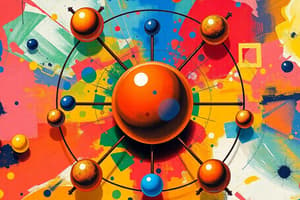Podcast
Questions and Answers
What is an atom?
What is an atom?
The smallest particle of an element that retains its identity in a chemical reaction.
What were the limitations of Democritus's ideas about the atoms?
What were the limitations of Democritus's ideas about the atoms?
He did not test his theory and had no scientific evidence to back it up.
Using Dalton's atomic theory, describe how atoms interact during a chemical reaction.
Using Dalton's atomic theory, describe how atoms interact during a chemical reaction.
During a chemical reaction, atoms are either joined, separated, or rearranged. They are never changed into atoms of a different element.
What experimental evidence did Thomson have for 'electrons have a negative charge'?
What experimental evidence did Thomson have for 'electrons have a negative charge'?
What experimental evidence did Thomson have for 'atoms of all elements contain electrons'?
What experimental evidence did Thomson have for 'atoms of all elements contain electrons'?
Would you expect 2 electrons to attract or repel?
Would you expect 2 electrons to attract or repel?
How do the charge and the mass of a neutron compare to the charge and mass of a proton?
How do the charge and the mass of a neutron compare to the charge and mass of a proton?
Why does it make sense that if an atom loses electrons, it is left with a positive charge?
Why does it make sense that if an atom loses electrons, it is left with a positive charge?
Describe the location of the electrons in Thomson's plum pudding model of the atom.
Describe the location of the electrons in Thomson's plum pudding model of the atom.
How did the results of Rutherford's gold-foil experiment differ from his expectations?
How did the results of Rutherford's gold-foil experiment differ from his expectations?
What is the charge of the nucleus of every atom?
What is the charge of the nucleus of every atom?
In the Rutherford atomic model, which subatomic particles are located in the nucleus?
In the Rutherford atomic model, which subatomic particles are located in the nucleus?
Why is an atom electrically neutral?
Why is an atom electrically neutral?
What does the atomic number of each atom represent?
What does the atomic number of each atom represent?
What is the difference between the mass number and the atomic number of an atom?
What is the difference between the mass number and the atomic number of an atom?
Name 2 ways that the isotopes of an element differ.
Name 2 ways that the isotopes of an element differ.
How can there be more than 1000 different atoms when there are only about 100 different elements?
How can there be more than 1000 different atoms when there are only about 100 different elements?
What data must we know about the isotopes of an element to calculate the atomic mass of the element?
What data must we know about the isotopes of an element to calculate the atomic mass of the element?
How is an average mass different from a weighted average mass?
How is an average mass different from a weighted average mass?
What is the atomic mass of an element?
What is the atomic mass of an element?
How are the elements arranged in a modern periodic table?
How are the elements arranged in a modern periodic table?
Characterize the size of an atom.
Characterize the size of an atom.
Compare the size and the density of an atom with the nucleus.
Compare the size and the density of an atom with the nucleus.
Describe the numbers and kinds of subatomic particles in a boron-11 nucleus.
Describe the numbers and kinds of subatomic particles in a boron-11 nucleus.
What parts of Dalton's atomic theory no longer agree with the current picture of the atom?
What parts of Dalton's atomic theory no longer agree with the current picture of the atom?
How did Millikan calculate the mass of an electron?
How did Millikan calculate the mass of an electron?
How is the number of electrons in an atom of a given element related to the atomic number of that element?
How is the number of electrons in an atom of a given element related to the atomic number of that element?
Dalton's atomic theory was not correct in every detail. Should this be taken as a criticism of Dalton as a scientist?
Dalton's atomic theory was not correct in every detail. Should this be taken as a criticism of Dalton as a scientist?
Why are atoms considered the basic building blocks of matter, even though smaller particles, such as protons and electrons exist?
Why are atoms considered the basic building blocks of matter, even though smaller particles, such as protons and electrons exist?
Flashcards are hidden until you start studying
Study Notes
Atoms and Their Properties
- Atoms are the smallest units of elements that maintain their chemical identity during reactions.
- An atom is electrically neutral due to equal numbers of protons (positive charge) and electrons (negative charge).
Historical Perspectives on Atoms
- Democritus lacked experimental evidence to support his atomic theory, leading to limitations in his ideas.
- Dalton's atomic theory posited that atoms are rearranged in chemical reactions but never transformed into different elements.
Key Discoveries in Atomic Structure
- Thomson's experiments revealed that cathode rays are made of negatively charged particles, now known as electrons.
- Thomson concluded that all atoms contain electrons because results were consistent across different materials, showing a constant charge-to-mass ratio.
Atomic Models and Experiments
- In Thomson's "plum pudding" model, electrons are embedded in a positively charged "soup."
- Rutherford's gold-foil experiment showed unexpected deflection of alpha particles, indicating a dense, positively charged nucleus.
Nuclear Components
- The nucleus consists of protons (positive charge) and neutrons (neutral charge), making it dense compared to the larger, less dense atom.
- The atomic number represents the number of protons in an atom, dictating elemental identity.
Isotopes and Atomic Mass
- Isotopes are variations of an element with differing mass numbers due to different numbers of neutrons.
- The atomic mass is a weighted average of isotopes based on their natural abundance and mass.
Periodic Table Organization
- Elements in the modern periodic table are arranged by increasing atomic number, reflecting their proton count.
- Atomic structure is characterized by being predominantly empty space, with a small, dense nucleus.
Fundamental Concepts in Atomic Theory
- Dalton's atomic theory is outdated in aspects like the indivisibility of atoms and the identity of isotopes within elements.
- Millikan determined electron charge and mass through calculated procedures based on Thomson's findings.
- Atoms are the fundamental building blocks of matter, preserving the chemical properties of elements despite the existence of smaller subatomic particles.
Studying That Suits You
Use AI to generate personalized quizzes and flashcards to suit your learning preferences.




